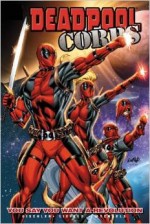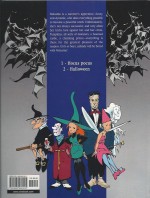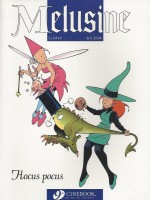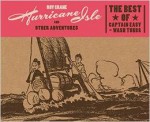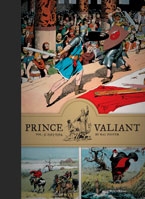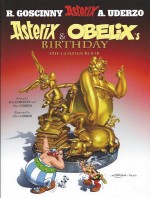
By R. Goscinny & A. Uderzo (Orion)
ISBN: 978-1-4440-0095-5
One of the most-read comics series in the world, the chronicles of Asterix the Gaul have been translated into more than 100 languages; with numerous animated and live-action movies, TV series, assorted toys and games and even their own tourist hotspot (Parc Astérix, near Paris). More than 325 million copies of the 35 canonical Asterix books have sold worldwide, making Goscinny & Uderzo France’s bestselling international authors.
The diminutive, doughty hero was created in 1959 by two of the art-form’s greatest proponents, René Goscinny & Albert Uderzo: masters of strip narrative then at the peak of their creative powers. Although their perfect partnership ended in 1977 with the death of prolific scripter Goscinny, the creative wonderment continued with Uderzo writing and drawing the feature until his retirement in 2010.
His last work on the feature was this compilation of new and old material which was designed to signify and celebrate 50 glorious years of his co-creation. In 2013 a new adventure – Asterix and the Picts – opened a fresh chapter in the annals as Jean-Yves Ferri & Didier Conrad began their much anticipated and dreaded continuation of the franchise.
Like everything great, the core premise of the immortal series works on multiple levels: ostensibly, younger readers enjoy the action-packed, lavishly illustrated comedic romps where conniving, bullying baddies always get their just deserts, whilst more worldly readers enthuse over the dry, pun-filled, slyly witty satire, enhanced for English speakers by the brilliantly light touch of translator Anthea Bell who played no small part in making the indomitable Gaul so palatable to the Anglo-Saxon world. Personally I still thrill to a perfectly delivered smack in the mush as much as a painfully swingeing string of bad puns and dry cutting jibes…
The eponymous hero is a smart, bold underdog who resists the iniquities, experiences the absurdities and observes the myriad wonders of Julius Caesar‘s Roman Empire with brains, bravery and a bit of magic potion. The stories were alternately set on the tip of Uderzo’s beloved Brittany coast, where a small village of redoubtable warriors and their families resisted every effort of the Roman Empire to complete their conquest of Gaul or throughout the expansive Ancient World circa 50 BC.
Unable to defeat this last bastion of Gallic insouciance, the mostly victorious invaders resorted to a policy of cautious containment. Thus the little seaside hamlet is permanently hemmed in by the heavily fortified garrisons of Totorum, Aquarium, Laudanum and Compendium.
The Gauls don’t care: they daily defy the world’s greatest military machine by just going about their everyday affairs, protected by the magic potion of resident druid Getafix and the shrewd wits of a rather diminutive dynamo and his weak-minded super-strong best friend…
Firmly established as a global brand and premium French export by the mid-1960s, Asterix continued to grow in quality as Goscinny & Uderzo toiled ever onward, crafting further fabulous sagas; building a stunning legacy of graphic excellence and storytelling gold.
Ren̩ Goscinny was one of the most prolific Рand remains one of the most-read Рwriters of strips the world has ever seen. A Parisian born in 1926, he was raised in Argentina where his father taught mathematics. From an early age the boy showed artistic promise. He studied fine arts, graduating in 1942, and while working as junior illustrator at an ad agency in 1945 was invited by an uncle to stay in the USA, where he found work as a translator.
After National Service in France Goscinny settled in Brooklyn and pursued a creative career, becoming in 1948 an art assistant for a little studio which included Harvey Kurtzman, Will Elder, Jack Davis and John Severin as well as a couple of European giants-in-waiting: Maurice de Bévère (“Morrisâ€, with whom Rene produced Lucky Luke from 1955-1977) and Joseph Gillain (Jijé). He also met Georges Troisfontaines, head of the World Press Agency, the company that provided comics for the French magazine Spirou.
After contributing scripts to Belles Histoires de l’Oncle Paul and ‘Jerry Spring’ Goscinny was made head of World Press’ Paris office, where he first met his life-long creative partner Albert Uderzo (Jehan Sepoulet, Luc Junior) as well as creating Sylvie and Alain et Christine (with “Martial†– Martial Durand) and Fanfan et Polo (drawn by Dino Attanasio).
In 1955 Goscinny, Uderzo, Jean-Michel Charlier and Jean Hébrard formed the independent Édipress/Édifrance syndicate, generating magazines for general industry (Clairon for the factory union and Pistolin for a chocolate factory). Scripting for Uderzo he produced Bill Blanchart, Pistolet and Benjamin et Benjamine, whilst writing and illustrating Le Capitaine Bibobu.
Under the pen-name Agostini he wrote Le Petit Nicholas (drawn by Jean-Jacques Sempé) and in 1956 began an association with the revolutionary comics magazine Tintin, writing stories for many illustrators including Signor Spagetti (Dino Attanasio), Monsieur Tric (Bob De Moor), Prudence Petitpas (Maréchal), Globule le Martien and Alphonse (both by Tibet), Modeste et Pompon (for André Franquin), Strapontin (Berck) as well as Oumpah-Pah with Uderzo. He also scripted strips for the magazines Paris-Flirt and Vaillant.
In 1959 Édipress/Édifrance launched Pilote and Goscinny went into overdrive. The first issue starred his and Uderzo’s instant masterpiece Asterix the Gaul, debuted Jacquot le Mousse and Tromblon et Bottaclou (drawn by Godard) and also re-launched Le Petit Nicolas and Jehan Pistolet/Jehan Soupolet.
When Georges Dargaud bought Pilote in 1960, Goscinny became editor-in-Chief, but still found time to add new series Les Divagations de Monsieur Sait-Tout (Martial), La Potachologie Illustrée (Cabu), Les Dingodossiers (Gotlib) and La Forêt de Chênebeau (Mic Delinx).
He also wrote frequently for television. In his spare time he created a little strip entitled Les Aventures du Calife Haroun el Poussah for Record (first episode January 15th 1962) illustrated by Swedish-born Jean Tabary. A minor success, it was re-tooled as Iznogoud when it transferred to Pilote.
Goscinny died in November 1977.
In the post-war reconstruction of France, Albert Uderzo returned to Paris and became a successful artist in the country’s burgeoning comics industry. His first published work, a pastiche of Aesop’s Fables, appeared in Junior, and in 1945 he was introduced to industry giant Edmond-François Calvo (whose own masterpiece The Beast is Dead is long overdue for a new archival edition…).
Equally indefatigable, Uderzo’s subsequent creations included indomitable eccentric Clopinard, Belloy, l’Invulnérable, Prince Rollin and Arys Buck. He illustrated Em-Ré-Vil’s novel Flamberge, worked in animation, as a journalist and illustrator for France Dimanche, and created the vertical comicstrip ‘Le Crime ne Paie pas’ for France-Soir. In 1950 he even illustrated a few episodes of the franchised European version of Fawcett’s Captain Marvel Jr. for Bravo!
An inveterate traveller, the prodigy met Goscinny in 1951. Soon fast friends, they decided to work together at the new Paris office of Belgian Publishing giant World Press. Their first collaboration was in November of that year; a feature piece on savoir vivre (how to live right or gracious living) for women’s weekly Bonnes Soirée, after which an avalanche of splendid strips and serials poured forth.
Both Jehan Pistolet and Luc Junior were created for La Libre Junior and they invented a spoof western starring a Red Indian (ah, simpler, if more casually racist, times…) who evolved into the delightfully infamous Oumpah-Pah. In 1955 with the formation of Édifrance/Édipresse, Uderzo drew Bill Blanchart for La Libre Junior, replaced Christian Godard on Benjamin et Benjamine and in 1957 added Charlier’s Clairette to his portfolio.
The following year, he made his Tintin debut as Oumpah-Pah finally found a home and a rapturous, devoted audience. Uderzo also drew Poussin et Poussif, La Famille Moutonet and La Famille Cokalane.
When Pilote launched in 1959 Uderzo was a major creative force for the new magazine collaborating with Charlier on Les Aventures de Tanguy et Laverdure whilst working with Goscinny on a little something called Asterix…
Although the ancient Gaul was a massive hit from the start, Uderzo continued working on Tanguy et Laverdure, but as soon as epic was collected as Ast̩rix le gaulois in 1961 it became clear that the series would demand most of his time Рespecially as the incredible Goscinny never seemed to require rest or run out of ideas.
By 1967 the strip occupied all Uderzo’s attention, and in 1974 the partners formed Idéfix Studios to fully exploit their inimitable creation. At the same time, after nearly 15 years as a weekly comic strip subsequently collected into compilations, 21st tale (Asterix and Caesar’s Gift) was the first to be published as a complete original album before being serialised. Thereafter each new release was a long anticipated, eagerly awaited treat for the strip’s millions of fans…
When Goscinny passed away three years later, Uderzo had to be coaxed and convinced to continue the sagas as writer and artist. He produced a further ten volumes until his retirement in 2010.
According to UNESCO’s Index Translationum, Uderzo is the tenth most-often translated French-language author in the world and the third most-translated French language comics author – right after his old mate René Goscinny and the grand master Hergé.
After the controversial reception to 2005’s Asterix and the Falling Sky, Uderzo’s 34th and last outing with his creations took four years to materialise and was once again not what was expected.
In the manner of a TV clip show or “roastâ€, the anniversary saga wove snippets and rarely seen ancillary material into a beguiling parade of gently surreal congratulation preceded by a Foreword from the doughty Gaul himself and a moving and laudatory recollection by Goscinny’s daughter Anne, after which the usual set-up pages lead into a strange scene…
It is the year 1 (or 0, depending on your grasp of arithmetic) AD. Fifty years after the heyday of the indomitable Gaulish resistance the regular characters are old but still as bellicose as ever. The world however is no longer a place of constant turmoil and adventure. Elderly Asterix has again dumped his horde of grandkids on aged uncle Obelix but both long for the days of having fun and bashing Romans.
Then as Uderzo physically injects himself into the tale the scene magically shifts, the heroes regain youth and vitality and in 50 BC the village is frantically getting ready for a big party. Asterix and Obelix were born on the same day and this year’s birthday party is going to be monumental…
As Vitalstatistix makes another speech Geriatrix‘s glamorous young wife interrupts with a prophetic clothes show allowing readers to see what Obelix would look like as a fashion plate in eleven coming eras. Her sole design for Asterix is just as radical…
When the big guy’s unrequitable (in fact, happily married and utterly unaware) love Panacea sends him a birthday missive, Obelix has to admit that he cannot read and Druid Getafix lends him an alphabet book he’s been working on. The intensive course of study does not end well…
Next follows a selection of birthday greetings from inept Egyptian architect Edifis and Redbeard‘s far from unsinkable pirates, after which a touch of character assassination from Geriatrix and introspection by Druid Psychoanalytix segues into an intriguing set of designs and sketches in the manner of Leonardo da Vinci and the first present: a text and prose book entitled ‘The Circumbendibus Travel Guide’ delineating many of the fascinating places the Gauls have visited (based on an article by Goscinny originally seen in Pilote #347 16th June 1966)…
Also included is vibrant infomercial ‘Put Your Travels on the Map’ hosted by Cacofonix which is followed by more creative anachronism in the form of parody record covers and a glimpse at the pan-European Imperiovision Song Contest (Bards Only) plus a little girlish table-talk as the village women express their hidden feelings and secret imaginings about the bombastic birthday boys, as well as who should marry them…
As young entrepreneur Squareonthehypotenus offers plans for a theme park dedicated to the wonderful warriors, his plans are eagerly embraced by the villagers and encourage Druid Valueaddedtax to invent new types of potion, whilst impresario Laurensolivius imagines a time of moving pictures and the great dramas the story of the villagers will inspire…
Finally a section on the great art which will one day be created because of Asterix and Obelix (augmented by faux reproductions of famous artworks by da Vinci, Rodin, Delacroix, Edvard Munch, Arcimboldo, Manet and David) before tension breaks out after Queen Cleopatra and Julius Caesar finally arrive for the party.
She might eternally be grateful to the Gauls but the Emperor bears grudges and takes the opportunity to have his apothecary Choleramorbus add a little something nasty to the amphora of wine he’s giving as a gift…
As ever, Roman duplicity is no match for Gaulish guile…
More a collection of themed gags than a singular saga and packed with posters and sly in-jokes this is a delicious addition – or perhaps perk – to the long and glorious career of two of France’s greatest heroes – both the real ones and their fictive masterworks.
© 2009 Les Éditions Albert René/Goscinny-Uderzo. English translation: © 2009 Les Éditions Albert René/Goscinny-Uderzo. All rights reserved.

